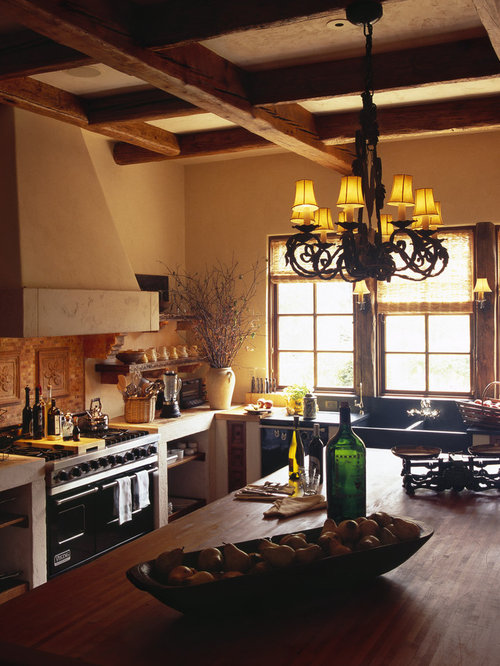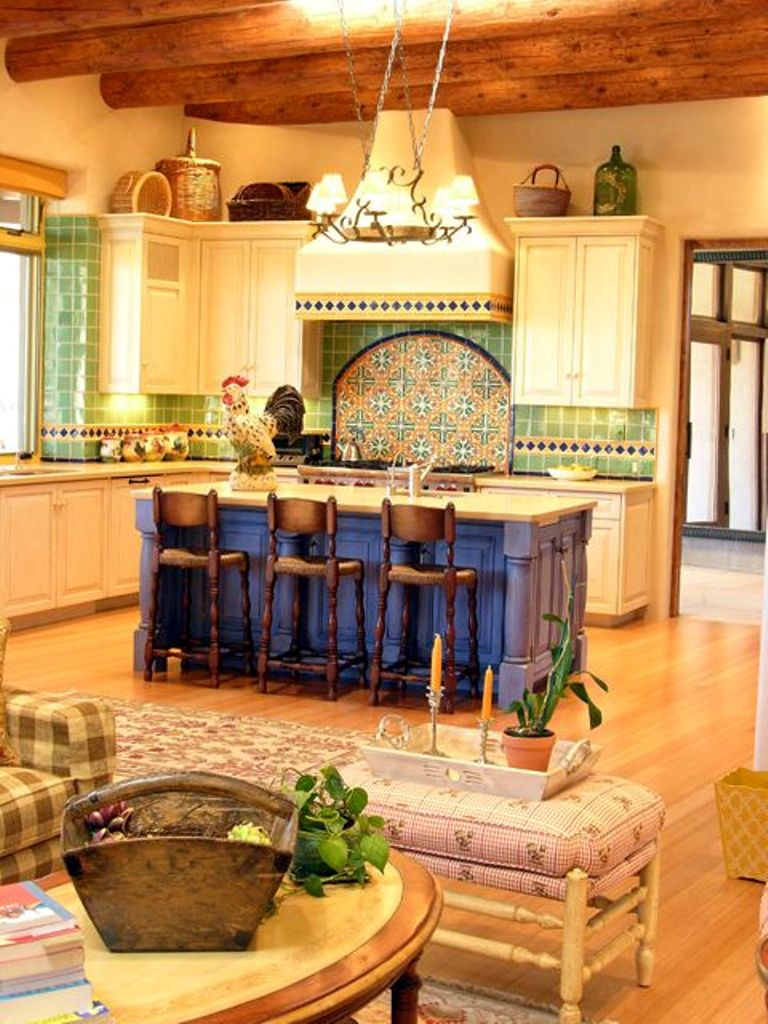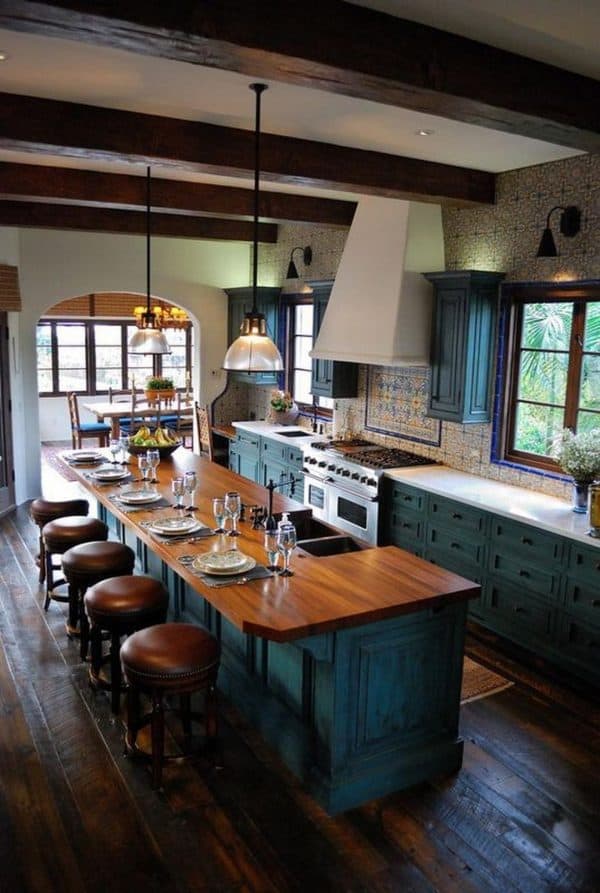Spanish-style kitchens are known for their warm, rustic charm and rich, earthy tones, which blend traditional elegance with a comfortable, inviting atmosphere. The lighting in such kitchens plays a crucial role in establishing the ambiance, highlighting architectural details, and ensuring the functionality of the space. Spanish-style kitchen lighting is all about capturing this mood by using fixtures that combine both form and function, often with wrought iron, intricate designs, and warm, glowing light that enhances the room’s character.
One of the defining characteristics of Spanish-style kitchen lighting is the use of wrought iron fixtures. These light fixtures often come in the form of chandeliers, pendants, or wall sconces, and they add an authentic, old-world feel to the kitchen. Wrought iron is typically shaped into intricate designs, including scrolls, curls, and geometric patterns, which echo the artisanal craftsmanship associated with traditional Spanish decor. The dark, robust texture of wrought iron contrasts beautifully with lighter kitchen elements, such as tile work or whitewashed walls, drawing the eye to the light source and creating a focal point in the room.

In addition to wrought iron, another key element of Spanish-style lighting is the use of warm, ambient light. Lighting in Spanish kitchens is often diffused through lantern-style fixtures, frosted glass, or colored shades to create a soft glow that mimics the natural light found in Mediterranean climates. This helps to enhance the cozy, welcoming vibe that Spanish kitchens are known for. Amber or soft white light bulbs are frequently used to maintain a warm color temperature, ensuring the space feels both inviting and intimate.
Spanish-style kitchen lighting also embraces the use of natural materials, such as wood and ceramic. Many fixtures are crafted from wood, which pairs well with the natural beams often found in Spanish-style homes. Wooden chandeliers or pendants complement the rustic finishes of Spanish decor, adding warmth and texture to the lighting design. Ceramic is another common material used for lighting in these kitchens, particularly in the form of hand-painted tiles or pottery that can serve as decorative shades or even as wall-mounted lights.

The color palette for Spanish-style lighting is typically warm and earthy. Think deep browns, terracotta, and ochre. These colors reflect the tones commonly found in Spanish architecture, from clay tiles to stucco walls. Incorporating lighting fixtures with shades or details in these hues can enhance the overall aesthetic of the kitchen, helping to tie the lighting design into the broader decor. For example, a terracotta pendant light can beautifully complement a backsplash made from traditional Spanish tiles.
Layering the lighting is an essential aspect of Spanish-style kitchen design. While overhead lights, such as chandeliers or pendants, provide general illumination, it’s important to incorporate task lighting to ensure the kitchen is functional. Under-cabinet lighting, for example, is essential for illuminating countertops where food preparation takes place. Recessed lights or spotlights can also be used to highlight specific areas, such as a cooking range or an island, without detracting from the overall aesthetic of the room.

Task lighting in a Spanish-style kitchen can also be decorative. For instance, small wrought iron sconces can be installed under cabinets or near open shelves, providing both function and charm. The use of dimmer switches is another clever design choice, allowing homeowners to adjust the intensity of the light based on the time of day or the mood they want to create. By layering different types of lighting, you can ensure that your kitchen is both practical and beautiful.
In a Spanish-style kitchen, accent lighting plays a significant role in showcasing the room’s architectural features. Arched doorways, alcoves, or exposed brick walls can be highlighted with well-placed lighting fixtures, creating a dramatic effect that draws attention to these details. Wall sconces or recessed lights can be used to add depth and dimension, casting soft shadows that highlight the textural elements of the space. This not only enhances the overall ambiance but also adds a sense of grandeur and sophistication to the kitchen.
Spanish-style kitchens often feature open spaces and high ceilings, which means the lighting needs to be scaled appropriately. Large chandeliers or statement pendants are commonly used to anchor the space and provide adequate light for the entire room. These oversized fixtures also add to the dramatic, bold look that Spanish-style decor is known for. When selecting a chandelier or pendant for a Spanish kitchen, it’s essential to consider the scale of the room. A fixture that is too small will get lost in the space, while one that is too large can overwhelm the room.
:max_bytes(150000):strip_icc()/spanishkitchenwoodexposedbeamscobaltbluevikingstove-ce2ab46eca5c4f739b7fa0efc8ff1110.jpg)
When it comes to pendant lighting, Spanish kitchens often favor groupings of smaller pendants over a kitchen island or breakfast nook. These pendants may feature wrought iron detailing, colorful ceramic shades, or lantern-like shapes that evoke a traditional Spanish aesthetic. Clustered pendant lights add visual interest and provide focused illumination for specific tasks, such as cooking or dining while contributing to the overall decor of the kitchen.
Lantern-style lighting is another popular choice for Spanish kitchens. Whether hanging from the ceiling or mounted on the wall, these fixtures provide a rustic yet elegant touch. The design of Spanish lanterns typically features intricate metalwork, often with glass panels that diffuse the light softly throughout the room. These lanterns can be designed to look vintage, with an aged finish that enhances their old-world charm. Paired with other traditional elements, such as exposed wood beams or terracotta floors, lanterns can help create an authentic Spanish atmosphere.
The integration of natural light is also a hallmark of Spanish kitchen design. Large windows, often with decorative wrought iron grilles, allow sunlight to flood the space, reducing the need for artificial lighting during the day. However, during the evening or on cloudy days, well-placed sconces, pendants, or chandeliers ensure the kitchen remains bright and functional. Incorporating a mix of natural and artificial light helps to maintain the balance of warmth and comfort that is central to the Spanish style.

Another notable feature of Spanish kitchen lighting is the use of artistic light fixtures. These may include hand-painted ceramic pendants, custom-made wrought iron chandeliers, or even stained glass sconces. Incorporating artisanal lighting pieces not only adds a unique touch to the kitchen but also emphasizes the craftsmanship and attention to detail that is integral to Spanish decor. Artistic lighting can serve as a conversation piece, adding personality and a sense of heritage to the space.
Lighting in a Spanish-style kitchen is often used to enhance the sense of flow and openness within the space. Since Spanish kitchens are designed to be both social and functional, lighting is crucial in defining different zones within the room, such as cooking, dining, or entertaining areas. By using different types of lighting in each area, you can create a layered and cohesive look that guides the eye through the space. For example, a large chandelier over the dining table can serve as a focal point, while under-cabinet lighting ensures the work areas are properly illuminated.
Lastly, Spanish-style lighting often incorporates subtle elements of luxury. Brass or bronze accents on chandeliers, gold leaf detailing on pendant lights, or even crystal embellishments on sconces can add a touch of elegance to the rustic aesthetic. These small details elevate the overall look of the kitchen, ensuring it feels refined without losing the warmth and comfort that make Spanish kitchens so inviting.

Common Mistakes to Avoid:
Ignoring scale and proportion: One of the most common mistakes in Spanish-style kitchen lighting is choosing fixtures that are either too small or too large for the space. Spanish kitchens often feature high ceilings and large, open layouts, which require appropriately sized lighting fixtures to maintain balance. A small chandelier in a large room can look out of place, while an oversized pendant in a compact space can overwhelm the room.
Overlooking task lighting: While the ambiance is essential in a Spanish-style kitchen, functionality should never be sacrificed. Many homeowners focus too much on decorative lighting, such as chandeliers or pendants, and forget to include sufficient task lighting. Without proper lighting over countertops, sinks, and stovetops, the kitchen can become impractical to use for cooking and food preparation.
Using harsh, cool lighting: Spanish-style kitchens are known for their warm, inviting atmosphere. Using cool white or blue-toned lighting can disrupt this ambiance, making the kitchen feel stark and unwelcoming. Opt for warm or soft white bulbs to enhance the cozy, Mediterranean vibe of the space.
Neglecting to layer lighting: Relying on a single source of light, such as a chandelier or overhead pendant, can lead to uneven lighting and create dark spots in the kitchen. Layering your lighting by combining ambient, task, and accent lighting ensures that the entire room is well-lit and visually appealing.
Choosing overly modern fixtures: While modern lighting can be beautiful, it can clash with the traditional elements of a Spanish-style kitchen. Sleek, minimalistic fixtures often lack the intricate detailing and rustic charm that are hallmarks of Spanish design. Look for fixtures with wrought iron, ceramic, or wood finishes to stay true to the style.
Forgetting about dimmer switches: Spanish kitchens are meant to be versatile spaces for both casual family meals and formal gatherings. Installing dimmer switches allows you to adjust the lighting according to the occasion, helping to create the perfect mood for any event.

What types of light fixtures are best for a Spanish-style kitchen?
The best fixtures for a Spanish-style kitchen are those made from natural materials like wrought iron, wood, or ceramic. Wrought iron chandeliers or pendants with intricate scrollwork or geometric patterns are ideal. Lantern-style lights, ceramic pendant lights, and sconces also work well. These fixtures enhance the rustic yet elegant aesthetic typical of Spanish decor.
How can I make my kitchen lighting feel more authentic to Spanish design?
To make your kitchen lighting feel more authentic, focus on incorporating warm, ambient light through fixtures that feature earthy tones and natural materials. Use wrought iron or hand-painted ceramic light fixtures to evoke a traditional Spanish feel. Additionally, layer your lighting by using a combination of overhead lights, task lighting, and accent lights to highlight architectural details and create depth.
Can I use modern lighting in a Spanish-style kitchen?
While it’s possible to use modern lighting in a Spanish-style kitchen, you should carefully balance the two styles. Modern fixtures with clean lines and minimal detailing can clash with the rustic charm of traditional Spanish decor. If you prefer modern lighting, opt for fixtures with materials or finishes that complement the Spanish aesthetic, such as matte black metal or frosted glass.

What is the ideal color temperature for Spanish-style kitchen lighting?
The ideal color temperature for Spanish-style kitchen lighting is warm white, typically between 2,700K to 3,000K. This range provides a soft, amber glow that enhances the warm, earthy tones characteristic of Spanish kitchens. Avoid cool white lighting, as it can make the space feel too sterile and detract from the cozy, inviting ambiance.
How do I incorporate task lighting in a Spanish-style kitchen?
Incorporating task lighting in a Spanish-style kitchen can be done tastefully by choosing fixtures that complement the overall decor. Wrought iron or bronze under-cabinet lights work well to illuminate countertops without disrupting the room’s aesthetic. You can also install recessed lighting above work areas or use decorative sconces near open shelving for both function and style.
What is the role of accent lighting in a Spanish kitchen?
Accent lighting in a Spanish kitchen is used to highlight architectural features, such as arched doorways, exposed beams, or tile backsplashes. Wall sconces, recessed spotlights, or lantern-style fixtures can be used to draw attention to these details, creating depth and enhancing the overall ambiance of the room. Accent lighting adds an extra layer of sophistication to the space while maintaining its traditional charm.

Related Posts:
- Light Grey Wood Kitchen Cabinets
- Most Popular Kitchen Lighting
- Creative Kitchen Lighting
- Modern Kitchen Table Light Fixtures
- Large Play Kitchen With Lights And Sounds
- Modern Hanging Kitchen Lights
- Retro Kitchen Pendant Lights
- Led Can Lights For Kitchen
- Mission Style Kitchen Island Lighting
- Kitchen Lighting Regulations